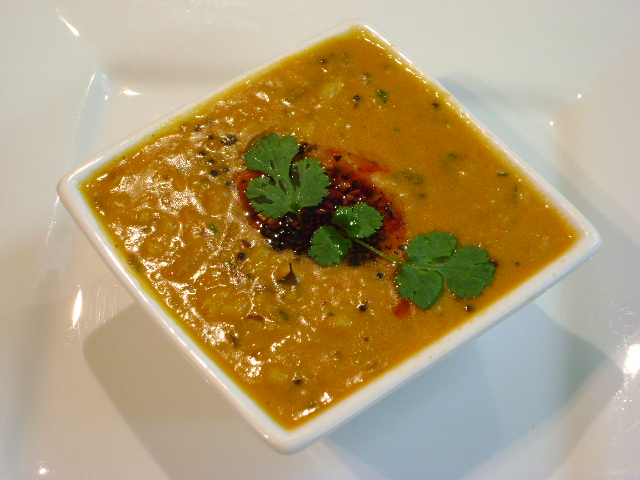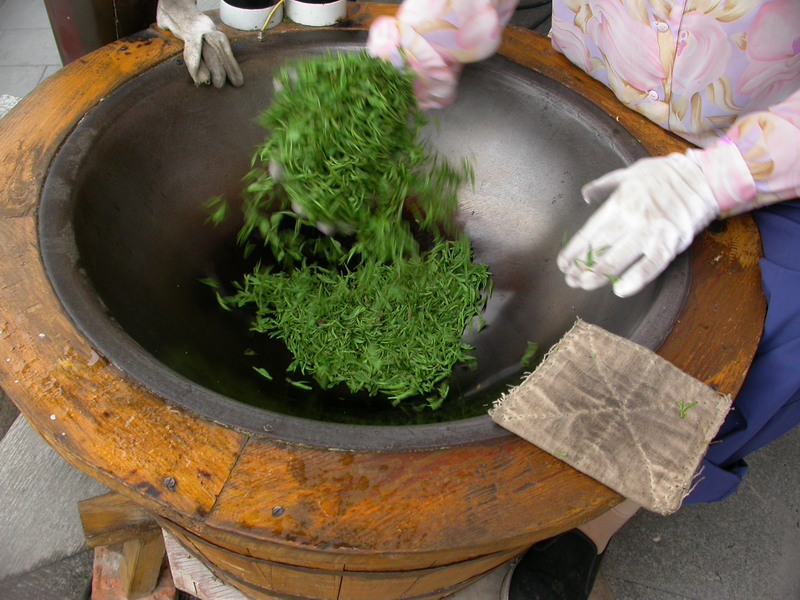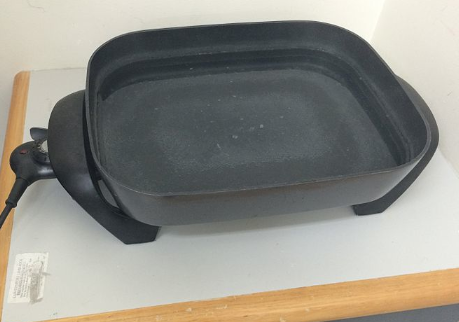|
Sautéing
Sautéing or sauteing (, ; , , 'jumped', 'bounced', in reference to tossing while cooking) is a method of cooking that uses a relatively small amount of oil or fat in a shallow pan over relatively high heat. Various sauté methods exist. Description Ingredients for sautéing are usually cut into small pieces or thinly sliced to provide a large surface area, which facilitates fast cooking. The primary mode of heat transfer during sautéing is conduction between the pan and the food being cooked. Food that is sautéed is browned while preserving its texture, moisture, and flavor. If meat, chicken, or fish is sautéed, the sauté is often finished by deglazing the pan's residue to make a sauce. Sautéing may be compared with pan frying, in which larger pieces of food (for example, chops or steaks) are cooked quickly in oil or fat, and flipped onto both sides. Some cooks make a distinction between the two based on the depth of the oil used, while others use the terms interchange ... [...More Info...] [...Related Items...] OR: [Wikipedia] [Google] [Baidu] |
Tempering (spices)
Tempering is a cooking technique used in India, Bangladesh, Nepal, Pakistan, and Sri Lanka in which whole spices (and sometimes also other ingredients such as dried chillies, minced ginger root or sugar) are cooked briefly in oil or ghee to liberate essential oils from cells and thus enhance their flavours, before being poured, together with the oil, into a dish. Tempering is also practiced by dry-roasting whole spices in a pan before grinding the spices. Tempering is typically done at the beginning of cooking, before adding the other ingredients for a curry or similar dish, or it may be added to a dish at the end of cooking, just before serving (as with a dal, sambar or stew). Ingredients used Ingredients typically used in tempering include cumin seeds, black mustard seeds, fennel seeds, '' kalonji'' (nigella seeds), fresh green chilis, dried red chilis, fenugreek seeds, asafoetida, cassia, cloves, urad dal, curry leaves, chopped onion, garlic, or tejpat leaves. When us ... [...More Info...] [...Related Items...] OR: [Wikipedia] [Google] [Baidu] |
Sweating (cooking)
__NOTOC__ Sweating in cooking is the gentle heating of vegetables in a little oil or butter, with frequent stirring and turning to ensure that any emitted liquid will evaporate. Sweating usually results in tender, sometimes translucent, pieces. Sweating is often a preliminary step to further cooking in liquid; onions, in particular, are often sweated before including in a stew. This differs from sautéing in that sweating is done over a much lower heat, sometimes with salt added to help draw moisture away, and making sure that little or no browning takes place. The sweating of vegetables has been used as a technique in the preparation of coulis. In Italy, this cooking technique is known as ''soffritto'', meaning "sub-frying" or "under-frying". In Italian cuisine, it is a common technique and preliminary step in the preparation of risotto, soups and sauces. File:Sweating onions.jpg, Close-up view of sweated onions See also * Braising * Frying * Sautéing Notes References ... [...More Info...] [...Related Items...] OR: [Wikipedia] [Google] [Baidu] |
Stir Frying
Stir frying ( zh, c= 炒, p=chǎo, w=ch'ao3, cy=cháau) is a cooking technique in which ingredients are fried in a small amount of very hot oil while being stirred or tossed in a wok. The technique originated in China and in recent centuries has spread into other parts of Asia and the West. It is similar to sautéing in Western cooking technique. Wok frying may have been used as early as the Han dynasty (206 BC – 220 AD) for drying grain, not for cooking. It was not until the Ming dynasty (1368–1644) that the wok reached its modern shape and allowed quick cooking in hot oil. However, there is research indicating that metal woks and stir-frying of dishes were already popular in the Song dynasty (960–1279), and stir-frying as a cooking technique is mentioned in the 6th-century AD Qimin Yaoshu. Stir frying has been recommended as a healthy and appealing method of preparing vegetables, meats, and fish, provided calories are kept at a reasonable level. The English-lan ... [...More Info...] [...Related Items...] OR: [Wikipedia] [Google] [Baidu] |
Saucier
A saucier () or sauté chef is a position in the classical brigade style kitchen. It can be translated into English as ''sauce chef''. In addition to preparing sauces, the saucier prepares stews, hot hors d'œuvres, and sautés food to order. Although it is often considered the highest position of the station cooks, the saucier is typically still tertiary to the chef and sous-chef. Escoffier definition In Georges Auguste Escoffier's system of the classic kitchen brigade, outlined in his '' Guide Culinaire'', the saucier is "responsible for all sautéed items and most sauces". See also * List of restaurant terminology This is a list of restaurant terminology. A restaurant is a business that prepares and serves food and drink to customers in return for money, either paid before the meal, after the meal, or with a running tab. Meals are generally served and eaten ... References {{DEFAULTSORT:Saucier Chefs Cookware and bakeware Restaurant terminology Culinary termin ... [...More Info...] [...Related Items...] OR: [Wikipedia] [Google] [Baidu] |
Pan Frying
Pan frying or pan-frying is a form of frying food characterized by the use of minimal cooking oil or fat (compared to shallow frying or deep frying), typically using just enough to lubricate the pan. In the case of a greasy food such as bacon, no oil or fats may need to be added. As a form of frying, the technique relies on oil or fat as the heat transfer medium, and on correct temperature and time to not overcook or burn the food. Pan frying can serve to retain the moisture in foods such as meat and seafood. The food is typically flipped at least once to ensure that both sides are cooked properly. Specifics Pan frying takes place at lower heat than sautéing. This is because the food to be pan fried – such as chicken breasts, steak, pork chops, or fish fillets – is ''not'' cut into small pieces before cooking. It requires a lower heat so that the exterior of the food does not overcook by the time the interior reaches the proper temperature, and to keep foods in a moister ... [...More Info...] [...Related Items...] OR: [Wikipedia] [Google] [Baidu] |
Sautéed Mushrooms
Sautéed mushrooms ( French: ''Champignons sautés au beurre'') is a dish prepared by sautéing edible mushrooms. It is served as a side dish, used as an ingredient in dishes such as coq au vin, beef bourguignon, and foods such as duxelles, as a topping for steaks and toast, and also as a garnish. Overview Sautéed mushrooms is a common dish prepared by the sautéing of sliced or whole edible mushrooms. Butter is typically used when sautéing the dish, and margarine and cooking oils such as olive oil and canola oil are also used. Clarified butter can be used, as can a mixture of oil and butter. The dish is typically cooked over a high heat until the mushrooms are browned, with the oil or butter being very hot in a pan before the mushrooms are added. Overcooking may create an inferior dish by causing the mushrooms to lose moisture and becoming shriveled. During the cooking process, the dish can be deglazed with the use of wine, and wine can be used as an ingredient in and ... [...More Info...] [...Related Items...] OR: [Wikipedia] [Google] [Baidu] |
Fond
In the culinary arts, fond is a contraction of ''fonds de cuisine'' which is loosely described as "the foundation and working capital of the kitchen". In its native usage, fond refers to the sauce created by dissolving the flavorful solid bits of food ('' sucs'') stuck to a pan or pot after cooking. In English speaking countries, it often refers to the bits themselves. These bits are deglazed with a liquid in order to produce a stock, broth, or sauce In cooking, a sauce is a liquid, cream, or semi- solid food, served on or used in preparing other foods. Most sauces are not normally consumed by themselves; they add flavour, texture, and visual appeal to a dish. ''Sauce'' is a French wor .... The name is an abbreviated form of the French word ''fondation'' (foundation in English). References Sauces Cooking techniques Culinary terminology {{food-stub ... [...More Info...] [...Related Items...] OR: [Wikipedia] [Google] [Baidu] |
Flambé
Flambé (, , ; also spelled flambe) is a cooking procedure in which Ethanol, alcohol is added to a hot pan to create a burst of flames. The word means "flamed" in French language, French. Flambéing is often associated with the tableside presentation of certain liqueur-drenched dishes set aflame, such as Bananas Foster or Cherries Jubilee when the alcohol is ignited and results in a flare of blue-tinged flame. However, flambéing is also a step in making coq au vin and other dishes and sauces, using spirits before they are brought to the table. By partially burning off the volatile alcohol, flambéing reduces the alcoholic content of the dish while keeping the flavors of the liquor. History Modern flambéing became popular in the 19th century. The English Christmas pudding was served flaming in Charles Dickens' 1843 novel, ''A Christmas Carol'': "the pudding... blazing in half of half-a-quarter of ignited brandy". The most common flambé dish appears to have been sweet omelette ... [...More Info...] [...Related Items...] OR: [Wikipedia] [Google] [Baidu] |
Agaricus Bisporus
''Agaricus bisporus'', commonly known as the cultivated mushroom, is a basidiomycete mushroom native to grasslands in Eurasia and North America. It is cultivated in more than 70 countries and is one of the most commonly and widely consumed mushrooms in the world. It has two color states while immature – white and brown – both of which have various names, with additional names for the mature state, such as chestnut, portobello, portabellini, button and champignon de Paris. ''A. bisporus'' has some poisonous lookalikes in the wild, such as '' Entoloma sinuatum''. Description The pileus or cap of the original wild species is a pale grey-brown, with broad, flat scales on a paler background and fading toward the margins. It is first hemispherical before flattening out with maturity, typically measuring in diameter. The narrow, crowded gills are free and initially pink, then red-brown, and finally a dark brown with a whitish edge from the cheilocystidia. The cylindrical ... [...More Info...] [...Related Items...] OR: [Wikipedia] [Google] [Baidu] |
Skillet
A frying pan, frypan, or skillet is a flat-bottomed pan used for frying, searing, and browning foods. It typically ranges from in diameter with relatively low sides that flare outwards, a long handle, and no lid. Larger pans may have a small grab handle opposite the main handle. A pan of similar dimensions, but with less flared, more vertical sides and often with a lid, is called a sauté pan. While a sauté pan can be used as a frying pan, it is designed for lower-heat cooking. History Copper frying pans were used in ancient Mesopotamia. Frying pans were also known in ancient Greece, where they were called () and teganon (τήγανον) and Rome, where they were called ''patella'' or ''sartago''. The word ''pan'' derives from the Old English . Before the introduction of the kitchen stove in the mid-19th century, a commonly used cast-iron cooking pan called a 'spider' had a handle and three legs used to stand up in the coals and ashes of the fire. Cooking pots and pans ... [...More Info...] [...Related Items...] OR: [Wikipedia] [Google] [Baidu] |






